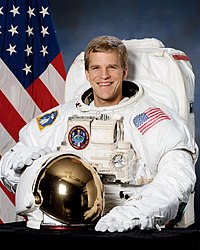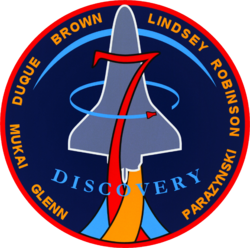Scott E. Parazynski
| Scott Edward Parazynski | |
 | |
| NASA-astronaut | |
|---|---|
| Född | 28 juli 1961 Little Rock, Arkansas |
| Tid i rymden | 57 dagar, 15 timmar, 34 minuter |
| Urvalsgrupp | Astronautgrupp 14 |
| Antal rymdpromenader | 7 st |
| Rymdpromenadtid | 47 timmar, 5 minuter |
| Uppdrag | STS-66, STS-86, STS-95, STS-100, STS-120 |
| Uppdragsemblem | |
Scott Edward Parazynski, född 28 juli 1961 i Little Rock, är en amerikansk astronaut uttagen i astronautgrupp 14 den 5 december 1992.
Rymdfärder

Källor
”Biographical Data” (på engelska) (PDF). NASA. oktober 2012. https://www.nasa.gov/wp-content/uploads/2016/01/parazynski_scott.pdf?emrc=32bb04. Läst 16 november 2024.
Media som används på denna webbplats
The STS-95 patch, designed by the crew, is intended to reflect the scientific, engineering, and historic elements of the mission. The Space Shuttle Discovery is shown rising over the sunlit Earth limb, representing the global benefits of the mission science and the solar science objectives of the Spartan Satellite. The bold number '7' signifies the seven members of Discovery's crew and also represents a historical link to the original seven Mercury astronauts. The STS-95 crew member John Glenn's first orbital flight is represnted by the Friendship 7 capsule. The rocket plumes symbolize the three major fields of science represented by the mission payloads: microgravity material science, medical research for humans on Earth and in space, and astronomy.
Författare/Upphovsman: Steve Jurvetson, Licens: CC BY 2.0
It was a special treat to watch NASA astronaut Scott Parazynski (the only person to reach both outer space and the top of Mount Everest) learn the delayed feedback of ballast trimming to try to hit a target depth without overshooting.
He drew many analogies to his five trips to the space station and seven spacewalks. He replaced the CO2 scrubbers, which bore a visual similarity to Apollo 13. I had to request that they carry duct tape on every dive. =)
He told us that when their CO2 levels hit 3%, they had to end their spacewalks. We kept it well below that, but had to surface when we found a wreck on sonar but the CO2 crept to 1% with all of our heavy breathing.
He starts off tall, too tall to fly on Soyuz as he learned the hard way after learning Russian and preparing for the flight only to be disqualified the end of the process!
But on the ISS, he elongates by a full 2.5 inches as his spinal disks expand in microgravity. This came back to haunt him on his first Everest attempt, where high on the mountain, his L2/L3 disc ruptured, requiring surgical repair. He was ever the optimist. Up there, he said, there is an unlimited supply of ice for your back.
HD Video compilation.STS-66 Mission Insignia
The STS-86 flight was the seventh shuttle-Mir docking mission, symbolized by seven stars. The international crew includes astronauts from the United States, Russia, and France. The flags of these nations are incorporated in the rays of the astronaut logo. The rays of light streaking across the sky depict the orbital tracks of the two spacecraft as they prepare to dock. During the flight, an American astronaut and a Russian cosmonaut will perform an extravehicular activity (EVA). The mercator projection of Earth illustrates the global cooperative nature of the flight.
Portrait of Dr. Scott Parazynski
STS120-S-001 (February 2007) --- The STS-120 patch reflects the role of the mission in the future of the space program. The shuttle payload bay carries Node 2, the doorway to the future international laboratory elements on the International Space Station. On the left the star represents the International Space Station; the red colored points represent the current location of the P6 solar array, furled and awaiting relocation when the crew arrives. During the mission, the crew will move P6 to its final home at the end of the port truss. The gold points represent the P6 solar array in its new location, unfurled and producing power for science and life support. On the right, the moon and Mars can be seen representing the future of NASA. The constellation Orion rises in the background, symbolizing NASA's new exploration vehicle. Through all, the shuttle rises up and away, leading the way to the future. The NASA insignia design for Shuttle flights is reserved for use by the astronauts and for other official use as the NASA Administrator may authorize. Public availability has been approved only in the form of illustrations by the various news media. When and if there is any change in this policy, which is not anticipated, it will be publicly announced.
STS-100 Patch







